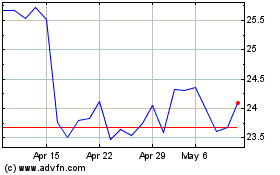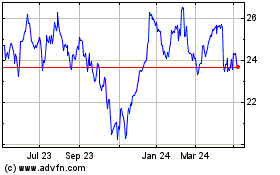Europe Steel Industry Can't Meet EU Carbon Emissions Target -Eurofer
05 July 2013 - 3:28AM
Dow Jones News
Europe's steel industry won't be able to cut its carbon dioxide
emissions by the levels recently postulated by the European
Commission, but it should be able to reduce them by an estimated
15% in an economically viable way by 2050, compared with levels in
2010, the steelmakers' association Eurofer said Thursday.
"The European Commission's reduction targets [are] beyond reach
of the steel sector," said Eurofer's general director Gordon Moffat
in a statement. "The steel industry cannot stay in Europe if the
commission's targets are imposed on the sector without further
adaptation."
The commission's recently published document, "Roadmap for
moving to a low-carbon economy in 2050," postulates a reduction of
80% to 95% by 2050, from levels in 1990, for European industry,
including steel.
Eurofer said in a report Thursday that in its "economic
scenario," only a 10% emissions reduction per metric ton of steel
would be possible between 2010 and 2030, and 15% between 2010 and
2050. This would be brought about by the use of best available
technologies, process optimization and a greater use of steel
scrap, Eurofer said. The report is based on research by Boston
Consulting Group.
Greater reductions in carbon emissions could be achieved only by
major alterations to blast furnace installations and the use of
"radical, new and yet unproven breakthrough technologies," Eurofer
said. ArcelorMittal (MT), the world's biggest steelmaker, said it
agreed with Eurofer's position on emissions.
Research into ultra-low CO2 steelmaking technology, or ULCOS,
started in 2004 and has been tested at pilot-plant level, but
hasn't yet been used on an industrial scale, Eurofer said.
Steelmaker Tata Steel (500470.BY), which is working on the
development of an ULCOS technology called HISarna, which is
financially supported by the European Union and the Dutch Ministry
of Economic Affairs, Thursday described the European Commission's
targets for steelmakers' emissions as "unfeasible."
"If the European steel industry is to succeed in its efforts to
develop breakthrough low-carbon iron making technologies, a more
favourable legislative environment is needed," a Tata Steel
spokesman said. "Sensible legislation that adequately supports
high-cost breakthrough initiatives like HIsarna is a prerequisite,
combined with a regulatory framework that does not impose
unrealistic targets."
Write to Diana Kinch at diana.kinch@dowjones.com
-0-
Subscribe to WSJ: http://online.wsj.com?mod=djnwires
ArcelorMittal (EU:MT)
Historical Stock Chart
From Sep 2024 to Oct 2024

ArcelorMittal (EU:MT)
Historical Stock Chart
From Oct 2023 to Oct 2024
